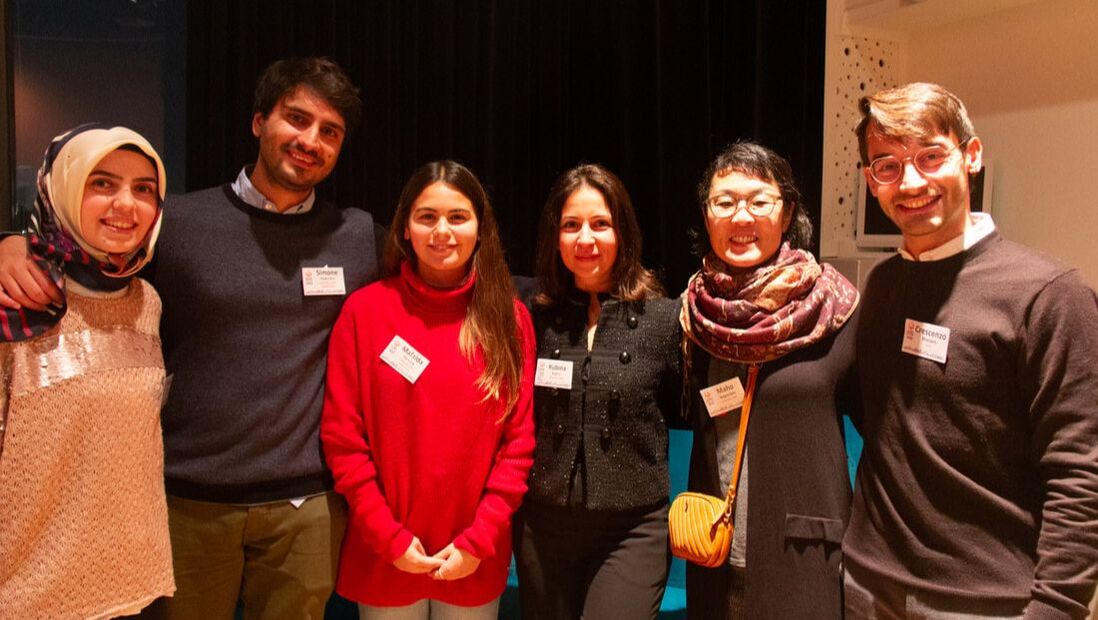TME group
|
Rubina Baglio Enzo Massaro Hilal Nur Sensoy Simone Foderaro Maho Nagasawa Celine De Schrijver Mafalda Ferreira You?? See Vacancies!! |
PI Postdoc PhD student PhD student Research technician Research technician Erasmus+ student |
Research lines
Extracellular vesicles in tumor inflammation and metastasis
Tumors are complex structures in which distinct cell types engage in intricate communication networks. The interactions between tumor and non-malignant cells at the primary tumor as well as at distant metastatic sites have a crucial role in cancer progression. We discovered that bone cancer cells release high amounts of extracellular vesicles (EVs) that “educate” mesenchymal stem cells (MSC) to favor cancer growth and metastasis formation. This effect was due to a dramatic change in the inflammatory cytokine expression profile of the mesenchymal cells and could be revoked using specific anti-inflammatory drugs.
Using in vivo cancer models and next generation techniques, we are facing the new exciting challenge to:
1) Comprehensively study the immunomodulatory properties of tumor-educated stromal cells
2) Evaluate whether specific combinations of immunomodulatory drugs can block the pro-metastatic actions of cancer EVs
3) Identify circulating biomarkers for treatment response prediction in cancer patient plasma, with a particular focus on circulating EV-associated growth factors and non-coding RNAs.
Liquid biopsy-based immuno-metabolic profiling for cancer patients’ personalized medicine
Prediction of response to immunotherapy is extremely complex, and current methods based on pre-treatment (static) biomarkers, such as immune checkpoint protein expression in tumor tissues, are insufficient if not inaccurate. Because of their probabilistic nature, responses to immunotherapy are more accurately predicted once therapy has started, underscoring the relevance of dynamic assessment of immune cell status through repetitive (liquid biopsy-based) sampling.
We are setting up a spectral flow cytometry strategy to assess 40 unique features of circulating lymphoid and myeloid cells in patients undergoing immunotherapy. Our approach is unique in that it addresses the metabolic status of immune cells, an increasingly recognized indicator of effector function1 that is ignored when using traditional flow cytometry.
Apart from common immune cell markers we can determine rare subsets of unconventional T cells, together with activation, immune checkpoint and metabolic protein expression using only low amount of input material, a major hurdle for deep immune profiling.
Exosome-mediated delivery of CRISPR-Cas9 components for cancer gene therapy
Since the bacterial CRISPR-Cas9 system was modified for use in human cells, it revolutionized scientific research and opened new avenues for gene therapy. However, safe and efficient delivery of the CRISPR-Cas9 gene editing components to cancer cells remains an unmet challenge.
Mesenchymal stem cell (MSC) exosomes are natural, non-immunogenic delivery vehicles for RNA and proteins, and are currently being tested in clinical trials for the treatment of inflammatory diseases.
We aim to exploit the natural propensity of exosomes to incorporate and transfer functional RNAs and proteins, to deliver the CRISPR-Cas9 system into cancer cells as a strategy for targeted gene therapy.
Tumors are complex structures in which distinct cell types engage in intricate communication networks. The interactions between tumor and non-malignant cells at the primary tumor as well as at distant metastatic sites have a crucial role in cancer progression. We discovered that bone cancer cells release high amounts of extracellular vesicles (EVs) that “educate” mesenchymal stem cells (MSC) to favor cancer growth and metastasis formation. This effect was due to a dramatic change in the inflammatory cytokine expression profile of the mesenchymal cells and could be revoked using specific anti-inflammatory drugs.
Using in vivo cancer models and next generation techniques, we are facing the new exciting challenge to:
1) Comprehensively study the immunomodulatory properties of tumor-educated stromal cells
2) Evaluate whether specific combinations of immunomodulatory drugs can block the pro-metastatic actions of cancer EVs
3) Identify circulating biomarkers for treatment response prediction in cancer patient plasma, with a particular focus on circulating EV-associated growth factors and non-coding RNAs.
Liquid biopsy-based immuno-metabolic profiling for cancer patients’ personalized medicine
Prediction of response to immunotherapy is extremely complex, and current methods based on pre-treatment (static) biomarkers, such as immune checkpoint protein expression in tumor tissues, are insufficient if not inaccurate. Because of their probabilistic nature, responses to immunotherapy are more accurately predicted once therapy has started, underscoring the relevance of dynamic assessment of immune cell status through repetitive (liquid biopsy-based) sampling.
We are setting up a spectral flow cytometry strategy to assess 40 unique features of circulating lymphoid and myeloid cells in patients undergoing immunotherapy. Our approach is unique in that it addresses the metabolic status of immune cells, an increasingly recognized indicator of effector function1 that is ignored when using traditional flow cytometry.
Apart from common immune cell markers we can determine rare subsets of unconventional T cells, together with activation, immune checkpoint and metabolic protein expression using only low amount of input material, a major hurdle for deep immune profiling.
Exosome-mediated delivery of CRISPR-Cas9 components for cancer gene therapy
Since the bacterial CRISPR-Cas9 system was modified for use in human cells, it revolutionized scientific research and opened new avenues for gene therapy. However, safe and efficient delivery of the CRISPR-Cas9 gene editing components to cancer cells remains an unmet challenge.
Mesenchymal stem cell (MSC) exosomes are natural, non-immunogenic delivery vehicles for RNA and proteins, and are currently being tested in clinical trials for the treatment of inflammatory diseases.
We aim to exploit the natural propensity of exosomes to incorporate and transfer functional RNAs and proteins, to deliver the CRISPR-Cas9 system into cancer cells as a strategy for targeted gene therapy.
Relevant publications:
- Harnessing EV communication to restore antitumor immunity. Massaro C, Wei M, Pegtel DM, Baglio SR. Adv Drug Deliv Rev. 2021 Jun 15:113838.
- A Preclinical Mouse Model of Osteosarcoma to Define the Extracellular Vesicle-mediated Communication Between Tumor and Mesenchymal Stem Cells. Lagerweij T, Pérez-Lanzón M, Baglio SR. J Vis Exp. 2018 May 6.
- Biogenesis and function of extracellular vesicles in cancer. Bebelman MP, Smit MJ, Pegtel DM, Baglio SR. Pharmacol Ther. 2018 Feb 21.
- Blocking tumor-educated MSC paracrine activity halts osteosarcoma progression. Baglio SR, Lagerweij T, Pérez Lanzón M, Xuan Ho D, Léveillé N, Melo SA, Cleton-Jansen AM, Jordanova ES, Roncuzzi L, Greco M, van Eijndhoven MA, Grisendi G, Dominici M, Bonafede R, Lougheed S, de Gruijl TD, Zini N, Cervo S, Steffan A, Canzonieri V, Martson A, Maasalu K, Koks S, Wurdinger T, Baldini N, Pegtel DM. Clinical Cancer Research. 2017 Jan 4.
- Sensing of latent EBV infection through exosomal transfer of 5'pppRNA. Baglio SR, van Eijndhoven MA, Koppers-Lalic D, Berenguer J, Lougheed SM, Gibbs S, Léveillé N, Rinkel RN, Hopmans ES, Swaminathan S, Verkuijlen SA, Scheffer GL, van Kuppeveld FJ, de Gruijl TD, Bultink IE, Jordanova ES, Hackenberg M, Piersma SR, Knol JC, Voskuyl AE, Wurdinger T, Jiménez CR, Middeldorp JM, Pegtel DM. Proc Natl Acad Sci U S A. 2016 113:E587-96.
- Human bone marrow- and adipose-mesenchymal stem cells secrete exosomes enriched in distinctive miRNA and tRNA species. Baglio SR, Rooijers K, Koppers-Lalic D, Verweij FJ, Pérez Lanzón M, Zini N, Naaijkens B, Perut F, Niessen HW, Baldini N, Pegtel DM. Stem Cell Res Ther. 2015 Jul 1;6:127.


